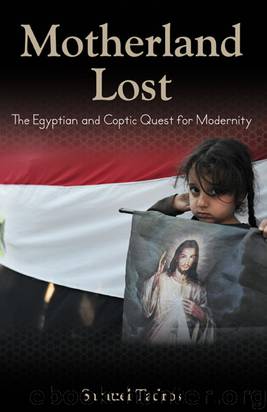Motherland Lost by Tadros Samuel;

Author:Tadros, Samuel;
Language: eng
Format: epub
Tags: Egypt, Copts, Christianity, Islam, modernity, National Unity, history, political challenges
Publisher: Hoover Institution Press
Published: 2013-02-25T16:00:00+00:00
DEFINING EGYPT
The main competitors to the new elite were the old Turkish elite and Syrian immigrants who were increasingly employed by the British. In 1892, a decree was issued limiting government employment to Egyptians. Egyptians were defined as either those born in the country or Ottoman subjects residing in the country for the past fifteen years. More limiting decrees would be issued in the future and would indicate the growing ability of the new elite to push aside its competitors. The numerous British civil servants spread in Egyptian ministries were another obstacle to the advancement of the new elite and anger towards the British, especially given their arrogance towards Egyptians, played a key role in kindling the fires of resentment towards the occupation.
The new circle of intellectuals had come a long way from their days as friends and disciples of Mohamed Abduh. They had completely abandoned Islam as the basis for politics and the nation and wanted to limit religion to the private sphere. They replaced Islam with nationalism on territorial basis. The Egyptian nation, as Lutfi El Sayed and his colleagues argued, had kept a pharaonic core throughout the centuries. The new Egypt they conceived was not new at all. They traced it to the ancient past. While the long years of Islamic Egypt had made the pharaohs little more than an ancient unfamiliar heritage, the European obsession with the pharaohs had managed to impress Egyptian minds. If the world stood in awe of that great ancient civilization, it was but natural that the Sons of the Nile take pride in their heritage and attempt to claim it for their national project. Later on, the discovery of the tomb of Tutankhamen would lead to a huge fascination with the pharaonic past and would leave an impact on contemporary Egyptian art as evidenced by Saad Zaghloul’s tomb.
While political nationalism is certainly a modern phenomenon born out of modernity, for the nationalist ideologue, the nation always existed. This led to absurd attempts to paint Egyptian history as an unbroken chain of nationalist struggle against occupiers. Arguments for the purity of pharaonic blood were accompanied by the proliferation of articles tracing the nationalist struggle of the pharaohs against the Hyksos, c. 1800 BC, and against every new occupier from the Persians, the Ptolemaic, and the Romans. Historical figures such as Ahmose, were imagined and discovered as nationalist heroes as is evidenced by Naguib Mahfouz’s early novels.5
It was from this foundation that the National Unity discourse finally emerged and it is precisely for this reason that the Coptic question was problematic. Egypt was one homogeneous nation. Diversity was neither acknowledged nor tolerated. In a sense, nationalism was understood as a hat. One could not wear more than one. Either one was an Egyptian or something else, but not both.6 This meant that any suggestion by Copts that they formed a distinct nation was not only not welcomed but had to be suppressed. Copts and Muslims were described as two elements of the Egyptian nation.
Download
This site does not store any files on its server. We only index and link to content provided by other sites. Please contact the content providers to delete copyright contents if any and email us, we'll remove relevant links or contents immediately.
| Arms Control | Diplomacy |
| Security | Trades & Tariffs |
| Treaties | African |
| Asian | Australian & Oceanian |
| Canadian | Caribbean & Latin American |
| European | Middle Eastern |
| Russian & Former Soviet Union |
The Secret History by Donna Tartt(18161)
The Social Justice Warrior Handbook by Lisa De Pasquale(11953)
Thirteen Reasons Why by Jay Asher(8451)
This Is How You Lose Her by Junot Diaz(6439)
Weapons of Math Destruction by Cathy O'Neil(5830)
Zero to One by Peter Thiel(5490)
Beartown by Fredrik Backman(5357)
The Myth of the Strong Leader by Archie Brown(5238)
The Fire Next Time by James Baldwin(5016)
How Democracies Die by Steven Levitsky & Daniel Ziblatt(4958)
Promise Me, Dad by Joe Biden(4908)
Stone's Rules by Roger Stone(4857)
100 Deadly Skills by Clint Emerson(4691)
A Higher Loyalty: Truth, Lies, and Leadership by James Comey(4550)
Rise and Kill First by Ronen Bergman(4545)
Secrecy World by Jake Bernstein(4388)
The David Icke Guide to the Global Conspiracy (and how to end it) by David Icke(4380)
The Farm by Tom Rob Smith(4323)
The Doomsday Machine by Daniel Ellsberg(4245)
